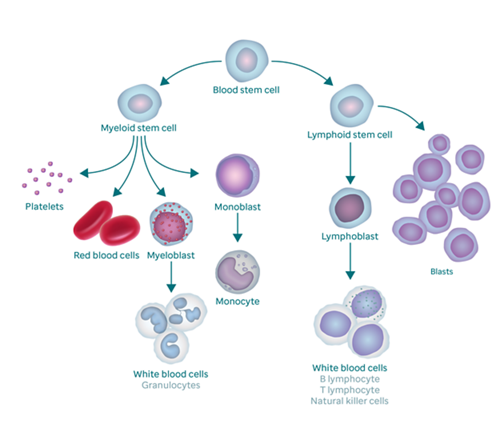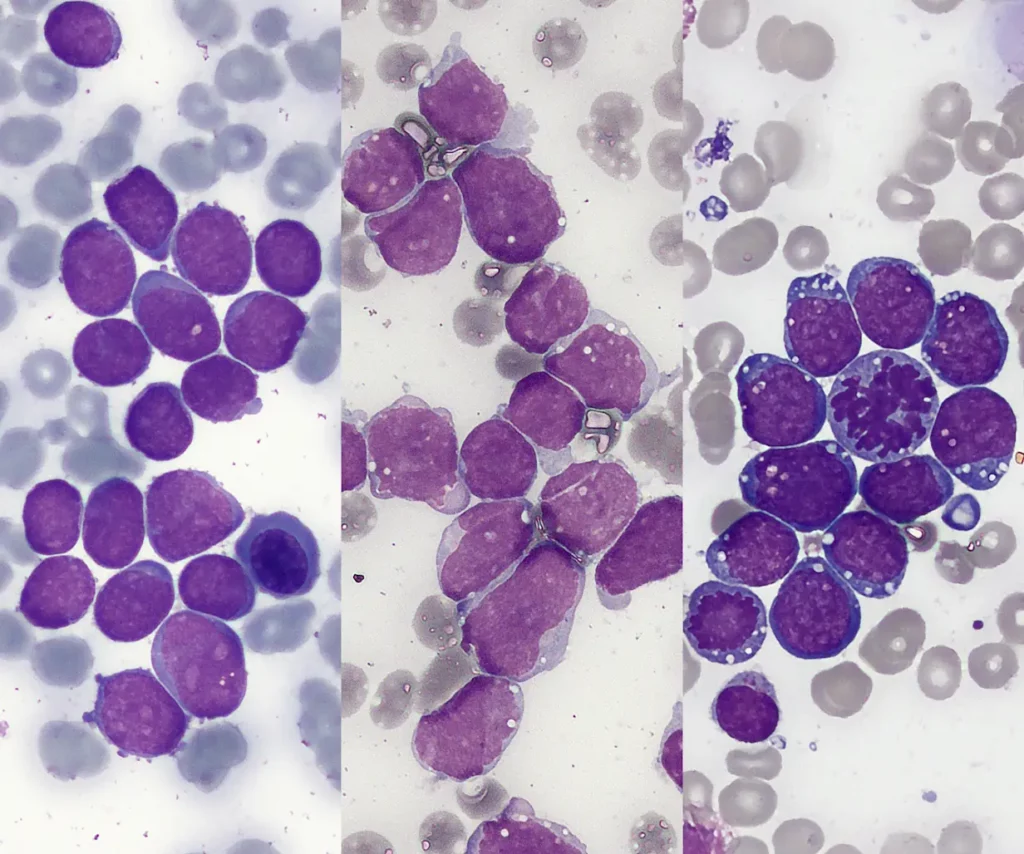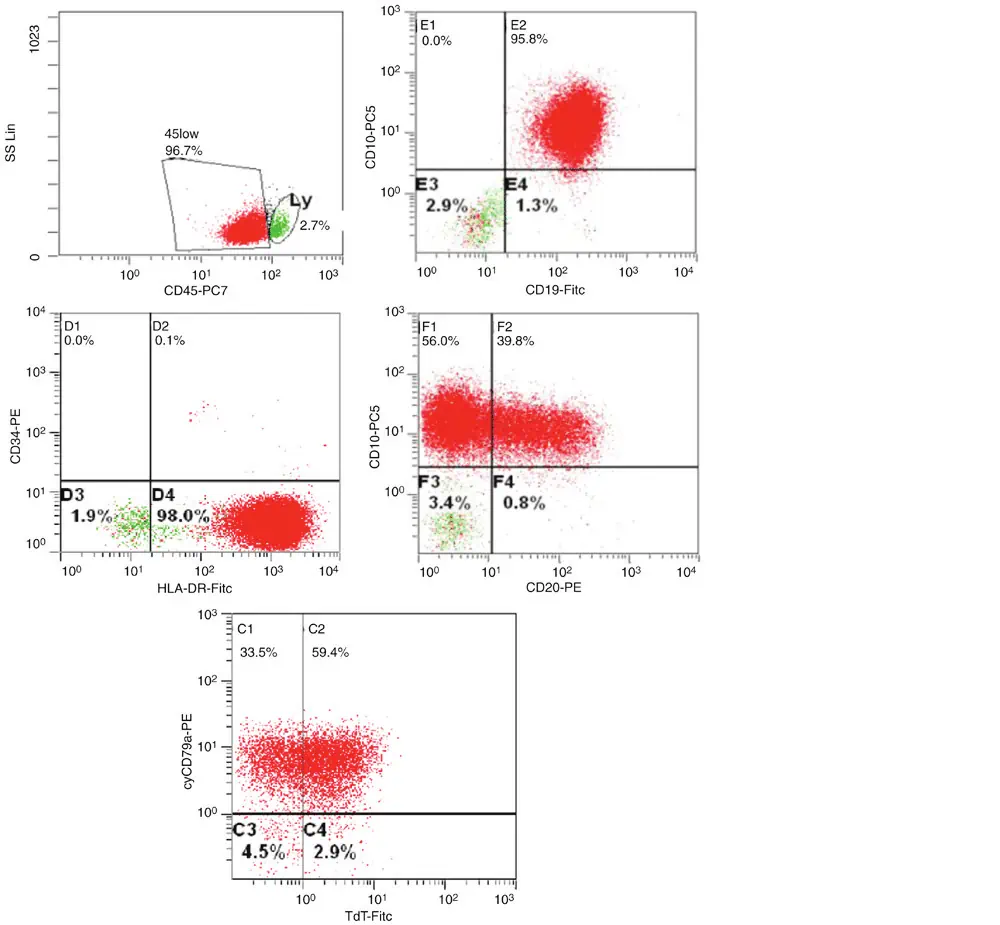Acute lymphoblastic leukemia (ALL) is a type of blood cancer that starts from young white blood cells called lymphocytes in the bone marrow. It is the most common type of cancer in children, but can also affect adults
Table of Contents
- Key Points about ALL
- How common is ALL in Kenya?
- Risk Factors for Acute Lymphoblastic Leukemia
- Signs and Symptoms of Acute Lymphoblastic Leukemia
- Prevention Strategies
- Screening Modalities
- Diagnosis of Acute Lymphoblastic Leukemia in Kenya
- Brief Summary Treatment and Management of ALL in Kenya
- References
- Author
Key Points about ALL
- ALL is a malignancy of B or T lymphoblasts characterized by uncontrolled proliferation of immature lymphocytes
- It leads to the replacement of bone marrow elements and other lymphoid organs
- Symptoms are related to anemia, thrombocytopenia, and neutropenia due to the replacement of the bone marrow with the abnormal leukemic cells
Blood cells formation process in the bone marrow

How common is ALL in Kenya?
- ALL accounts for approximately 2% of lymphoid neoplasms in Kenya
- The incidence of ALL is about 3.3 cases per 100,000 children
- Most ALL cases affect children ages 2 to 5 years
Risk Factors for Acute Lymphoblastic Leukemia
In most cases, the cause of ALL cannot be determined
- Previous cancer treatment with certain types of chemotherapy and radiation therapy
- Exposure to very high levels of radiation
- Certain genetic disorders like Down syndrome
Signs and Symptoms of Acute Lymphoblastic Leukemia
The signs and symptoms of leukemia are related to the diminished number of other blood cells as well as massive numbers of defective lymphocytic cancer cells. This is because of the replacement of normal blood cells by leukemic cells in the bone marrow.
The symptoms include:-
- Fever
- Fatigue
- Dizziness
- Palpitations
- Bleeding
- Bruising
- Palpable lymphadenopathy
- Bone pain
- Splenomegaly
- Infections
- Petechiae and ecchymoses[2][3][4]
Prevention Strategies
There are no specific prevention strategies for ALL. Avoiding exposure to high levels of radiation may reduce risk. Early and timely diagnosis with proper management can substantially improve cure rates and can be considered a secondary preventive strategy.
Screening Modalities
There are no routine screening tests for ALL. Diagnosis is based on blood tests, bone marrow aspiration and biopsy
Diagnosis of Acute Lymphoblastic Leukemia in Kenya
Diagnosis of acute lymphoblastic lymphoma depends on a combination of clinical history, examination and laboratory and imaging studies.
A) Clinical Features
B)Laboratory Diagnosis
Laboratory testing is the foundation of diagnosis of ALL. A combination of tests are used to make the diagnosis. These include:-
i) Complete blood count CBC with differential
A CBC or hemogram looks at the numbers of different blood cells and other components. In typical ALL cases, its common to find elevated counts of white blood cells (WBCs – Leucocytosis) The differential count shows an elevated number of lymphocytes (lymphocytosis), many of which would be blast cells (immature/abnormal blood cells).
Hemoglobin levels are usually low (i.e. anaemia) due to the replacement of normal red blood cells by abnormal blast cells. In addition, platelets may be low ( thrombocytopenia), due to the replacement of megakaryocytes, the precursors of platelets in the bone marrow. This is the reason patients with ALL tend to have bleeding tendencies.
ii) Peripheral blood Film (PBF) smear
A PBF is a quick and simple test that allows visualisation of abnormal cells in the blood under a microscope. It is very important in ascertaining the findings of the CBC and documenting the shape (morphology) and origin (lineage) of the abnormal cells.
iii)Bone marrow aspiration and biopsy
A bone marrow aspirate (BMA) is the gold standard in the diagnosis of ALL.
Identification of abnormal blast cells of lymphoid lineage is critical in confirming the diagnosis

iv) Immunocytochemistry/flow cytometry

Flow cytometry is a diagnostic study to define ALL into specific subtypes. The abnormal cells are identified and grouped according to the presence of specific proteins on their surface
Typical markers used in the diagnosis of BCP-ALL include CD19, CD10, CD34, and cytoplasmic immunoglobulin M (IgM).
The presence of these markers, along with others such as CD22, HLA-DR, and CD58, helps classify the leukemia into subgroups based on the maturation stage of the B cells.
For T-ALL, markers like CD3, CD7, CD5, and CD2 are typically expressed, allowing for effective lineage classification.
iv) Other Laboratory techniques
- Cytogenetics
- Fluorescence in situ hybridization
- Polymerase chain reaction
- Next-generation sequencing
In Kenya, several barriers to timely and accurate diagnosis of ALL have been identified.
Brief Summary Treatment and Management of ALL in Kenya
- Induction chemotherapy
- Consolidation chemotherapy
- Maintenance chemotherapy
- Tyrosine kinase inhibitors for Philadelphia chromosome-positive (Ph+) disease
- Rituximab for CD20-positive patients
- Intrathecal chemotherapy for central nervous system (CNS) prophylaxis
- Stem cell transplantation
- Supportive care (e.g. blood products, antibiotics, growth factors)[2][4]
With treatment, the 5-year overall survival rate for ALL is estimated at greater than 85%[3]. However, adults have a lower chance of cure compared to children[4][5].
Need More Info?
References
[1] https://www.cancerresearchuk.org/about-cancer/acute-lymphoblastic-leukaemia-all
[2] https://emedicine.medscape.com/article/207631-overview
[3] https://www.ncbi.nlm.nih.gov/books/NBK459149/
[4] https://my.clevelandclinic.org/health/diseases/21564-acute-lymphocytic-leukemia
[5] https://www.mayoclinic.org/diseases-conditions/acute-lymphocytic-leukemia/symptoms-causes/syc-20369077
Disclaimer
The information provided on this medical blog is for general informational purposes only and should not be considered as a substitute for professional medical advice. Always consult with a qualified healthcare provider before making any healthcare decisions or taking any actions based on the information provided on this blog. The authors and publishers of this blog are not liable for any errors or omissions in the content or for any actions taken based on the information provided.

